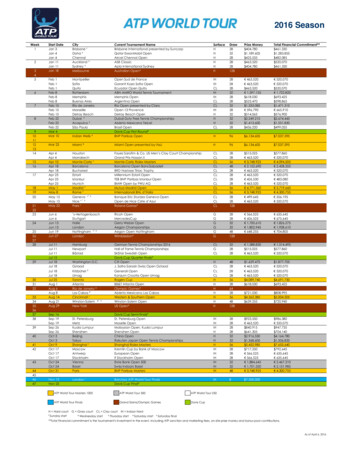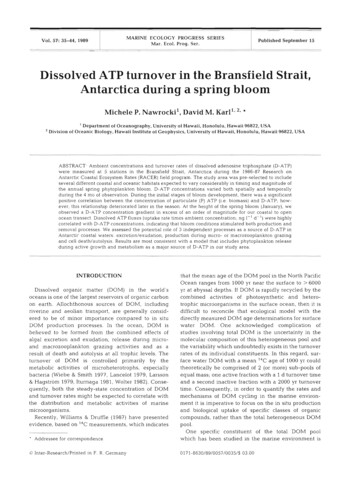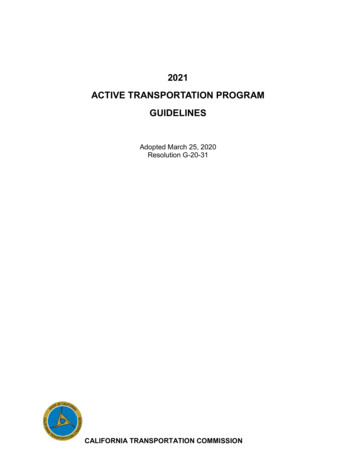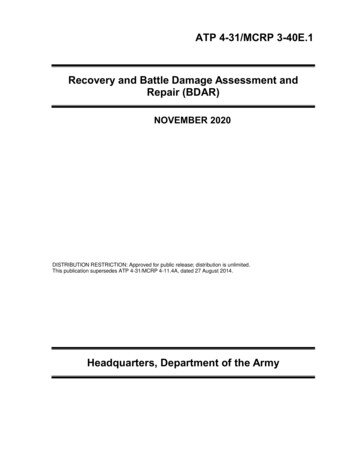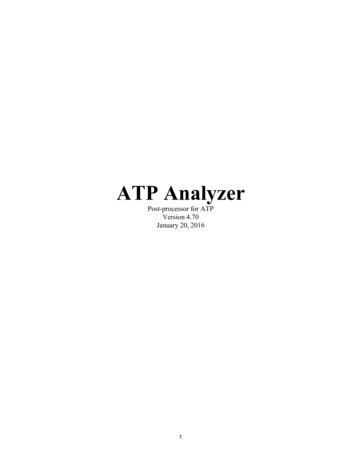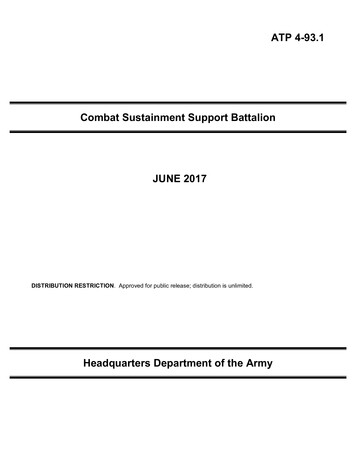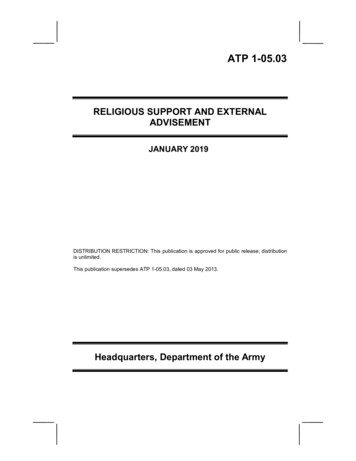
Transcription
ATP 1-05.03RELIGIOUS SUPPORT AND EXTERNALADVISEMENTJANUARY 2019DISTRIBUTION RESTRICTION: This publication is approved for public release; distributionis unlimited.This publication supersedes ATP 1-05.03, dated 03 May 2013.Headquarters, Department of the Army
This publication is available at the Army Publishing Directorate site(https://armypubs.army.mil), and the Central Army Registry d).
ATP 1-05.03HeadquartersDepartment of the ArmyWashington, DC, 31 January 2019Army Techniques PublicationATP 1-05.03Religious Support and External AdvisementContentsPagePREFACE . iiiINTRODUCTION . vChapter 1FUNDAMENTALS OF EXTERNAL ADVISEMENT . 1-1Chaplain Corps Mission . 1-1Religious Advisement . 1-2Religious Advisement Products . 1-9Chapter 2RELIGIOUS AREA ANALYSIS . 2-1Purpose . 2-1General Planning Guidelines . 2-1Analysis and Assessment of Religious Factors . 2-2Religious Area Analysis as a Product. 2-3Running Estimates . 2-5Religious Factors and the Running Estimate . 2-5Chapter 3RELIGIOUS IMPACT ASSESSMENTS . 3-1Purpose . 3-1Focal Points . 3-1Products . 3-2Distribution and Staffing . 3-2Modification . 3-3Chapter 4SOLDIER AND LEADER ENGAGEMENT . 4-1The Importance of Religion in Soldier and Leader Engagements . 4-1Engagements and the Levels of War . 4-4Engagements and the Operations Process . 4-5DISTRIBUTION RESTRICTION: This publication is approved for public release; distributionis unlimited.*This publication supersedes ATP 1-05.03, dated 3 May 2013.ATP 1-05.03i
ContentsAppendix A RELIGIOUS FACTORS IN ANALYSIS AND ASSESSMENT . A-1Appendix B RELIGIOUS ADVISOR AND SOLDIER AND LEADER ENGAGEMENT . B-1Appendix C SOLDIER AND LEADER ENGAGEMENT AND THE OPERATIONSPROCESS . C-1GLOSSARY .Glossary-1REFERENCES. References-1INDEX .Index-1FiguresFigure 1-1. Religious support logic map . 1-2Figure 1-2. Religious advisement and the operations process . 1-3Figure 1-3. External religious advisement process . 1-9TablesTable 1-1. Religious factors and the military decisionmakingprocess . 1-5iiATP 1-05.0331 January 2019
PrefaceATP 1-05.03 establishes a common understanding, foundational concepts, and methodsfor advising commanders on the impact of religion on operations. ATP 1-05.03highlights the external advisement capability for chaplains and religious affairsspecialists operating from battalion through echelons above corps to support the fullrange of military operations.The principal audience for ATP 1-05.03 is all members of the profession of arms.Commanders and staffs of Army headquarters serving as joint task force or multinationalheadquarters should also refer to applicable joint or multinational doctrine concerningthe range of military operations and joint or multinational forces. Trainers and educatorsthroughout the Army will also use this publication.Commanders, staffs, and subordinates ensure that their decisions and actions complywith applicable United States, international, and in some cases host-nation laws andregulations. Commanders at all levels ensure that their Soldiers operate in accordancewith the law of war and the rules of engagement. (See FM 27-10.)ATP 1-05.03 uses joint terms where applicable. Selected joint and Army terms anddefinitions appear in both the glossary and the text. For definitions shown in the text,the term is italicized and the number of the proponent publication follows the definition.ATP 1-05.03 applies to the Active Army, Army National Guard/Army National Guardof the United States, and United States Army Reserve unless otherwise stated.The proponent of ATP 1-05.03 is the United States Army Chaplain Center and School.The preparing agency is the Capabilities Development Integration Directorate, UnitedStates Army Chaplain Center and School. Send comments and recommendations on aDA Form 2028 (Recommended Changes to Publications and Blank Forms) toCommandant, United States Army Chaplain Center and School, ATTN: ATSC-CDID(ATP 1-05.03), 10100 Lee Road, Fort Jackson, SC 29207-7000 or call commercial;(803)751-8735/DSN 734-8735; email: usarmy.jackson.usachcs.mbx.cdid@mail.mil.Follow the Department of the Army (DA) Form 2028 format when submittingrecommended changes.31 January 2019ATP 1-05.03iii
This page intentionally left blank.
IntroductionATP 1-05.03 expands upon FM 1-05, Religious Support, in describing externaladvisement as a required capability of chaplain sections and unit ministry teams.Chaplain sections and unit ministry teams advise commanders at all echelons inoperational environments and Army elements in direct support of operations. Thereligious support “advise” capability is divided into external and internal advisement.External advisement involves advising commands on the impact of religious and culturalbeliefs and practices of populations external to the unit. Chaplains and religious affairsspecialists serving in joint force land component commands or joint task forces shouldrefer to JG 1-05, JP 3-0, and other joint publications for further guidance.ATP 1-05.03 contains four chapters and three appendices— Chapter 1 describes external advisement and its relationship to the ChaplainCorps mission and core competencies. Chapter 2 defines religious area analysis and its integration into theoperational variables analysis as part of the military decisionmaking process,and it links external advisement to development of a running estimate. Chapter 3 defines the religious impact assessment, its purpose and focalpoints, the types of products often constituting a religious impact assessment.It also describes the process for distributing and staffing a religious impactassessment and the follow-on modification of corollary products associatedwith external advisement and the operations process. Chapter 4 defines religion and Soldier and leader engagements and theirimpacts on unit missions. Appendix A provides an advisement model for developing a religious areaanalysis utilizing the operational variables approach. Appendix B defines the distinct roles and responsibilities associated withchaplains conducting Soldier and leader engagements. Appendix C provides guidelines on integrating Soldier and leaderengagements into the operations process.31 January 2019ATP 1-05.03v
This page intentionally left blank.
Chapter 1Fundamentals of External AdvisementCHAPLAIN CORPS MISSION1-1. The mission of the Army Chaplain Corps is to provide religious support (RS) tothe Army across the range of military operations by assisting commanders in providingfor the free exercise of religion and providing religious, moral, and ethical advisementand leadership. The Army Chaplain Corps possesses three core competencies (nurturethe living, care for the wounded, and honor the dead) executed through two requiredcapabilities, provide and advise. (See FM 1-05 for more information on the ArmyChaplain Corps mission. See DODD 1304.19 for more information on the ArmyChaplain Corps competencies.) External advisement occurs in this broader context. (Seefigure 1-1 on page 1-2.)31 January 2019ATP 1-05.031-1
Chapter 1Figure 1-1. Religious support logic mapRELIGIOUS ADVISEMENT1-2. As professional military religious advisors, chaplains advise commanders andstaffs on religion and its impact on all aspects of military operations. Chaplains do thisby advising commanders on the impact of religion in their units. This is internaladvisement, and it is addressed in ATP 1-05.04. They will also advise commanders onhow religion impacts a unit’s mission throughout its area of operations (AO). This isexternal advisement. (See figure 1-2.) The aim of external advisement is to helpcommanders and staffs more clearly understand how religion shapes the battlefield andimpacts mission success. As they better understand religion in an operationalenvironment (OE), they are better equipped to avoid offense and, even more important,better informed of the dynamics for building relationships of trust and forming valuablepartnerships. Therefore, chaplains must diligently guard against external advisementactivities that compromise their noncombatant role.1-2ATP 1-05.0331 January 2019
Fundamentals of External AdvisementFigure 1-2. Religious advisement and the operations process1-3. Internally chaplains are responsible for advising commanders on the religiouspractices and requirements of Soldiers and authorized civilians in the command, oftenunderstood as religious accommodation. This can include identifying holy days, worshiprequirements, dietary requirements, and wearing of religious garments. (See AR 600-20for more information on religious accommodation.)1-4. Externally chaplains advise commanders on the specifics of the religiousenvironment in their AO that may impact mission accomplishment. This includesanalysis, assessment, recommendations, engaging local populations, and trainingcommanders’ formations to act appropriately as related to mission success.EXTERNAL ADVISEMENT AND AN OPERATIONAL ENVIRONMENT1-5. The term “religious” refers to the system of beliefs and practices that givemeaning and purpose to people’s lives. Religious refers to professing a set of beliefsconcerning the cause, nature, and purpose of the universe, usually involving devotionaland ritual observances, and often containing a moral code governing the conduct ofhuman affairs. In its most basic form, religion identifies “ultimate concerns”, thosethings for which individuals or groups are willing to live or die. Therefore, religionshapes OEs, even those identified as primarily atheist or agnostic. As humans have31 January 2019ATP 1-05.031-3
Chapter 1concerns that extend beyond mere survival, commanders need to know, and, whereverpossible, understand how these concerns and values impact mission success. Thesevalues shape environments and inform commanders’ abilities to develop partnershipsand build relationships of trust.1-6. As part of planning, commanders consider how cultures and religions (their ownand others in an operational area) impact operations. Understanding the culture andreligion of a particular society or group in a society can significantly improve a force’sability to accomplish its mission. Understanding the culture of unified action partners iscrucial to building mutual trust and shared understanding. The core values of a culturecan be defined as deeply held beliefs of critical importance to its way of life. If chaplainsand religious affairs specialists can determine the core values of a culture and reward orcomplement those values, this will assist chaplains in operating with the members ofthat culture. If those values are threatened or belittled, a cultural impasse may be createdthat will negatively impact the conduct of unit operations.1-7. Because religion is often an integral part of the values set of a culture, missionpreparation and analysis should examine the religions and religious groups in an AO.Religious beliefs, leaders, and institutions are central to the worldview of manysocieties. The impact of religion on a local population must be considered when planningany operation. Chaplains participate in operational planning and advise commanders andstaffs on matters as appropriate, consistent with their noncombatant status. This includesindigenous religions in the AO, holy days that could impact military operations, and theimpact of local religious leaders, organizations, and religious structures.1-8. Religion has the ability to shape an OE and therefore to impact the operationsprocess. As the religious staff advisor, chaplains execute RS planning by activelyintegrating into the operations process. Chaplains will maintain their non-combatantstatus while integrating their expertise on religion into the military decisionmakingprocess (MDMP). (See table 1-1.) Chaplains and religious affairs specialists may workin boards, bureaus, centers, cells, and working groups to integrate their respectiveexpertise and knowledge with the collective expertise of staffs to focus on specificproblem sets and provide coherent staff recommendations to commanders.1-4ATP 1-05.0331 January 2019
Fundamentals of External AdvisementTable 1-1. Religious factors and the military decisionmaking processMDMPStepsReceipt ofmissionMissionanalysisOutputs Commander’s initialguidance. Initial allocation oftime. COA analysis(war games) ne COAsPotential decisionpoints.War-game results.Initial assessmentmeasures.Advantages anddisadvantages ofeach COA.COA selection. Update runningestimates. Update assumptions.COA course of actionIPB intelligence preparation of the battlefield31 January 2019RS capability requirements for concept of supportdevelopment (provide and advise). Determine RS internal and external advisementrequirements (advise). Continue RS for current mission (provide andadvise).Determine and develop— RS requirements for each COA for concept ofsupport development (provide and advise. Religious impact on operations (advise). Assess religious factors (advise). COA religious considerations—allies and others(advise) Religious acceptability—allies and population(advise).Analyze—Update assumptions.Approved COA COA developmentConsiderconsequences of eachCOA— COA approvalProblem and missionstatements.Initial commander’sintent.Initial planningguidance.Updated IPB andrunning estimate. Assumptions.COA COAcomparisonGather, research, and assess—Consider during COAdevelopment— COAdevelopmentReligious Inputs and Outputs RS requirements for development of concept ofsupport (provide and advise). Religious feasibility (provide and advise). Religious acceptability (provide and advise). Religious suitability (provide and advise).Compare— Religious requirements for concept of support foreach COA by phase (provide and advise). Religious factors impact on each COA by phase(advise). Update running estimate.Execute and assess— Develop and execute RS concept of support(provide and advise). Communicate plan to higher and subordinates andsupervise subordinate RS planning and execution(provide and advise). Assess for next planning cycle and update runningestimate (provide and advise).MDMP military decisionmaking processRSreligious supportATP 1-05.031-5
Chapter 11-9. Chaplains and religious affairs specialists advise commanders regarding religionand its impact on missions, including— An OE and its religious aspects, including any religious issues that mightmotivate military forces and the long-term impacts of military operations onthe indigenous religious climate. Religious implications for courses of action during planning. Positive and negative impacts on the local religious environment andoperational priorities with concern for religious freedom. Identify religious leaders as potential partners related to humanitarian reliefefforts and building relationships of trust including mitigating conditions thatgive rise to dislocated civilians.1-10. Commanders and staffs need relevant religious advisement to sustain missionsuccess. Chaplains and religious affairs specialists advise their commands on how localreligions motivate and influence indigenous populations. Commanders and staffs relyon chaplains and religious affairs specialists to help them navigate the complexities ofreligion in an OE. As a required capability, external religious advisement is— Provided by the chaplain as the principal military religious advisor and thereligious affairs specialist in a supporting role. Focused on the mission impact of indigenous religious factors. Continuously updated for relevancy. Dependent on research, collaboration, and objectivity. Includes Soldier and leader engagements, both those conducted by RSpersonnel and those conducted by others in the unit. Training of formations addressing religious and cultural awareness aimed atrespecting the populations in commanders’ AOs. Supported by other resources, including world religions chaplains.1-11. Chaplains and religious affairs specialists can advise their commands on howlocal religions motivate and influence indigenous populations. Chaplains and religiousaffairs specialists advise units on the impact derogatory terms or negative treatment ofindigenous people will have on mission success. The unit ministry team (UMT) will alsoadvise commanders and staffs and train formations on the elements of religion relatedto respecting local populations. The religious advisor capability is essential as theChaplain Corps supports the commander’s operation. Military leaders rely on theirchaplains to help them navigate the complexities of religious factors in an OE. Whileother staff sections may advise commanders on religion in an OE, including theintelligence section and civil affairs teams, the chaplain is the only one who does sofrom the perspective of a religious leader. As credentialed professionals and religiousleaders, chaplains are relationship experts, experienced with demonstrating respect andcare for others. When introduced as such, chaplains can help open lines ofcommunication for commanders and staffs to accomplish their missions. This implieschaplain sections and UMTs are fully integrated with other staff sections to maximizecooperation and staff work.1-6ATP 1-05.0331 January 2019
Fundamentals of External Advisement1-12. Chaplains and religious affairs specialists advise their commands on how todemonstrate respect for religious property and beliefs. Demonstrating respect for thereligious property and religious beliefs of the indigenous population is consistent withthe principles of the Army profession and Army Ethic.RELIGION AND WORLDVIEW1-13. As a framework for the execution of the required capability to advise thecommand on religion and military operations, chaplains and religious affairs specialistsmust understand the term “worldview.” A worldview is developed throughsocio-economic and cultural development. Worldview influences attitudes, beliefs, andcharacter and ultimately affects behavior. Chaplains and religious affairs specialistshave a role in analyzing, educating, and advising commanders and their staffs indeveloping an objective worldview. The worldview of a chaplain or religious affairsspecialist impacts their ability to look objectively at the beliefs and behaviors of others,which influences their execution of the external advisement capability. A worldviewis— The lens by which people receive, interpret and process information andevents in their lives. Shaped by the origins, upbringing, education, experience, ideology, religion,and belief system of each individual. A perspective which helps determine an individual’s reality. A worldviewdetermines how people will behave in certain circumstances. When analyzingworldview, chaplains consider— For what core values are they willing to fight? What is their perception of truth? What actions do they believe are morally right and wrong?1-14. In recent years the term “metanarrative” has been used to describe the story orunderstanding that informs a worldview. Research, Soldier and leader engagements, andcareful analysis help UMTs begin to understand the components of the metanarrativeinforming local populations’ worldviews.1-15. Different religious groups and cultures have different worldviews which canimpact military operations. In some societies, there are multiple religions in an AO, withone or more dominant. As a religious advisor, analyzing an operation with the belief thatall individuals are the same will lead to flawed understanding and have negativeconsequences. As a religious advisor, chaplains can increase a commander’s situationalunderstanding by determining behavior and sources of conflict and recommendingcourses of action to resolve it.1-16. The role of an advisor is to provide accurate and objective information to enablecommanders and staffs to achieve mission success. It is not to judge or compare anotherreligion to one’s own personal beliefs. Everyone in a unit has a worldview that is theresult of upbringing, choices, learning, and personal experience. For chaplains and formany religious affairs specialists, a personal worldview is closely connected to faith.They see things through their personal faith and beliefs. Chaplains and religious affairs31 January 2019ATP 1-05.031-7
Chapter 1specialists need to realize that their worldview can affect their ability to act as animpartial advisor to their commander and affect their ability to look objectively at thebeliefs and behaviors of others. If they spend too much energy and emotion in comparingother’s beliefs and behaviors to their own, chaplains and religious affairs specialists takethe risk of losing objectivity and may not be able to give commanders the facts requiredfor mission planning. Objectivity does not imply religious or ethical relativism. One may(and often will) personally disagree with beliefs and practices of populations incommanders’ AOs. That said, only objective analysis helps commanders and staffsunderstand how religion shapes an OE.1-17. An analysis of indigenous groups in an OE focuses on how their religion impactsthe mission. Multinational partners may also have significantly different religious andcultural worldviews that must be considered for an assessment of their impact on themission. Careful religious analysis will help commanders and staffs avoid thinking thateveryone living in an AO is the same. Commanders and staffs consider— What is the group’s worldview? Is it consistent in the group? All cultureshave a shared worldview that gives them a distinct identity, but no twoindividuals in a group have the exact same worldview. It is important toidentify where certain individuals may have significant individualdifferences. Are there significant variations in the group based on individual upbringing,experiences, and learning, and what is that impact on unit operations? It isthese variations of an individual’s worldview that can be used to have apositive impact on operations.1-18. The religious advisor’s integration into the operations process can helpcommanders and staffs gain a better understanding of how the local population thinksand behaves. This may help commanders and staffs better predict how unit operationswill impact the local population and vice versa.EXTERNAL ADVISEMENT AND DECISIVE ACTION1-19. Chaplains and religious affairs specialists support and advise commandersthroughout the operations process (planning, preparation, execution, and assessment) intheir area of expertise. In decisive action (offense, defense, stability, and defense supportof civil authorities), chaplains and religious affairs specialists work in the operationsprocess to integrate the external focus of the religious advisor capability with other staffactivities by providing relevant data on the impact of religion on unit operations. (Seefigure 1-3.) Situational understanding is the product of applying analysis anddiscernment to relevant information to determine the relationships among theoperational and mission variables to facilitate decisionmaking (ADP 5-0). The chaplainas religious advisor can impact the commander’s situational understanding through threeproducts: a running estimate, a religious area analysis, and a religious impactassessment.1-8ATP 1-05.0331 January 2019
Fundamentals of External AdvisementFigure 1-3. External religious advisement processRELIGIOUS ADVISEMENT PRODUCTS1-20. Religious advisement often requires products which either inform other productsor action and priorities for the command. These products include running estimates,religious area analysis, religious impact assessments, and products associated with theoperations process.EXTERNAL ADVISEMENT AND THE RUNNING ESTIMATE1-21. Effective plans and successful execution hinge on accurate and current runningestimates. A running estimate is the continuous assessment of the current situation usedto determine if the current operation is proceeding according to the commander’s intentand if planned future operations are supportable (ADP 5-0). Staff sections maintain arunning estimate focused on how their areas of expertise are postured to support futureoperations. Because an estimate may be needed at any time, running estimates must beinitially developed and continuously revised throughout an operation. For chaplainsections and UMTs, the running estimate both informs and is informed by the religiousarea analysis.31 January 2019ATP 1-05.031-9
Chapter 1RELIGIOUS AREA ANALYSIS DESCRIBED1-22. Religious area analysis is researching and collecting data from an OE related toreligion and organizing that data using the operational variables: political, military,economic, social, information, infrastructure, physical environment, and time(PMESII-PT). (See appendix A for more details on the operational variables.) Religiousarea analysis collects as much information about religion in an AO as time allows fromas wide a variety of resources as possible. The religious area analysis is often a 10 to12-page product which informs the religious impact assessment. The religious areaanalysis process enables chaplains and religious affairs specialists to disseminate theanalyzed information in a usable format for use by commanders, staffs, and otherchaplains and religious affairs specialists. A religious area analysis— Defines the religions in an AO. Identifies religious categories. Informs the religious impact assessment and running estimate. Is continuously updated as the result of Soldier and leader engagements,significant events in an AO, or changes in the running estimate.RELIGIOUS IMPACT ASSESSMENT1-23. The religious impact assessment determines how religion in an AO impacts aunit’s mission by determining how religion informs stability and security or is used todestabilize the legitimate government. The unit chaplain and religious affairs specialistdevelop a 1 to 2-page religious impact assessment based upon the information in therunning estimate, the religious area analysis, and information from other staff sectionsor higher echelon headquarters. (See appendix A for more detail on assessment.) Areligious impact assessment can— Inform the conduct of Soldier and leader engagements. Help develop future courses of action. Identify trends that impact the mission. Interpret the significance of actions. Appraise future possibilities with probable forecasts. Assist in clarifying problems and devising integrated solutions to complexproblems.1-24. Assessments address the questions of “How does the religion of the populationand unified action partners in the AO help or hinder the commander’s mission?”, “Howmuch does religion impacts military operations?”, and, “How do the religious factors inan OE impact operational planning to support decisive action?” A religious impactassessment— Assesses the strengths and vulnerabilities of religion in an OE. Assesses the influence of religion, religious leaders, festivals, symbols,rituals, sites and buildings, and historic events. Addresses common destabilizing themes related including—1-10ATP 1-05.0331 January 2019
Fundamentals of External Advisement Natural disasters, famine, or catastrophes that result in humanitariancrises and collections of dislocated civilians.Organized crime including human trafficking.RELIGIOUS FACTORS1-25. Many religious factors shape an OE. Chaplains and religious affairs specialistsanalyze the religious factors in their AO and weigh the impact of their influence on themission. Analysis of these religious factors provides commanders with an assessmenton how religion impacts an OE and the unit mission.1-26. When analyzing levels of religious factors, chaplains and religious affairsspecialists collect and consider specific items of information. For local, historic, andsymbolic influential religious si
3-3 Chapter 4 SOLDIER AND LEADER ENGAGEMENT . 4-1 The Importance of Religion in Soldier and Leader Engagements . 4-1 Engagements and the Levels of War . 4-4 Engagements and the Operations Process . 4-5. Contents ii ATP 1-05.03 31 January 2019 . Corps mission and core competencies. .
